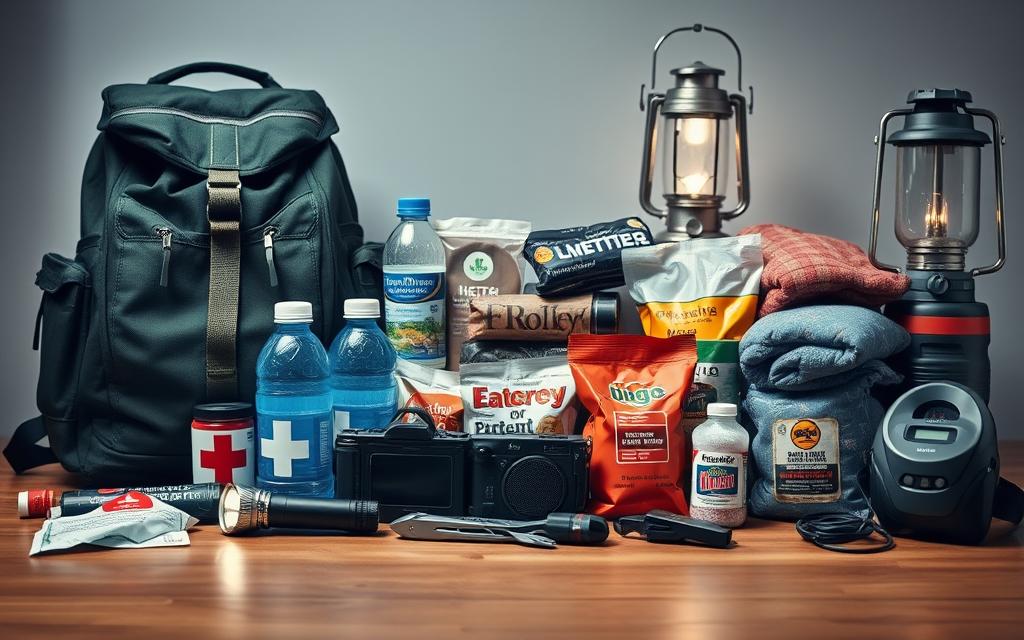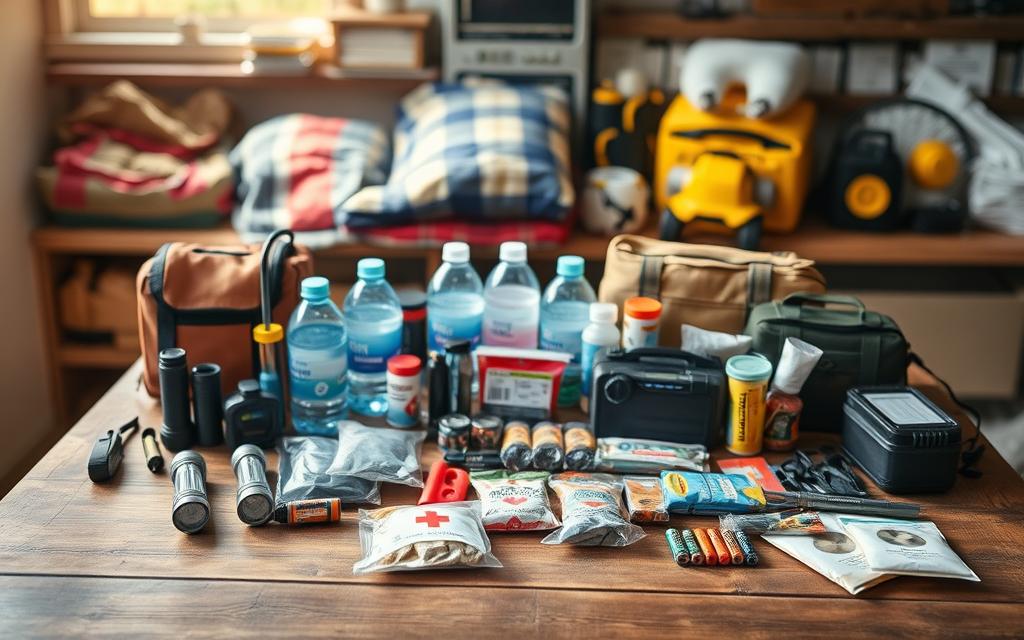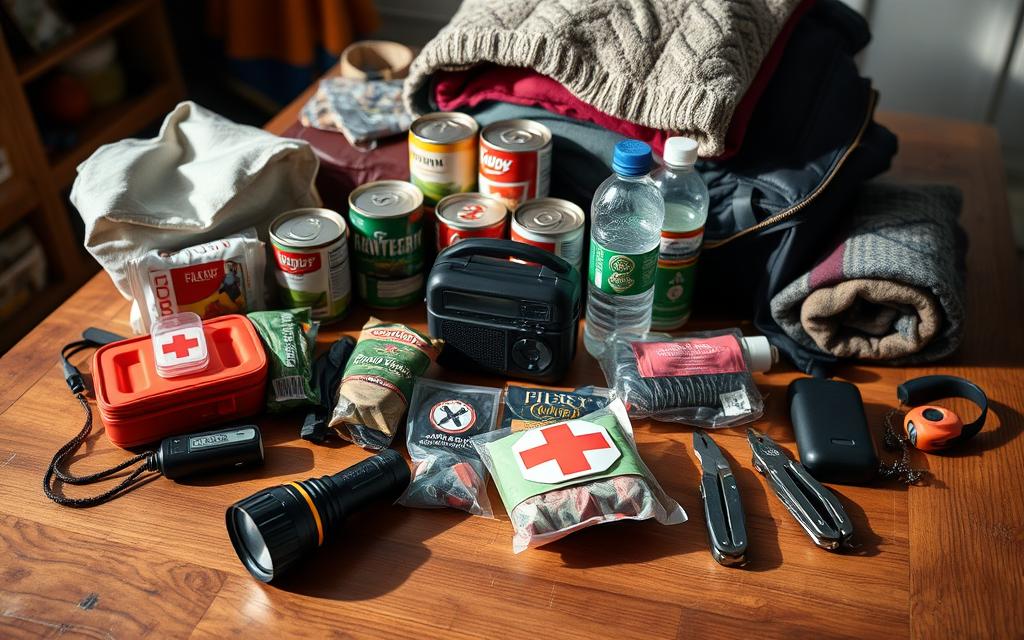Life can change in an instant. From sudden storms to unexpected power outages, unpredictable events remind us why planning ahead matters. Being prepared isn’t about fear—it’s about giving your family confidence to handle whatever comes your way.
Your household might face anything from natural disasters to medical crises. That’s why having a well-stocked kit with essentials like water, non-perishable food, and flashlights is critical. Experts emphasize storing supplies to last at least three days, as help may not arrive immediately.
Customizing your supplies ensures everyone’s needs are met. Think about medications, pet food, or items for older adults or those with disabilities. A little forethought today can prevent stress tomorrow.
Ready to take the next step? Let’s explore how to build a practical plan that keeps your loved ones safe and secure.
Overview and Importance of Emergency Preparedness
Disasters don’t warn, but your readiness can soften their blow. Unlike routine safety checks, true preparation means anticipating disruptions to water access, communication networks, and daily routines. It’s about creating a shield for your family and neighbors when systems we rely on falter.

What Makes Preparation Different
Think beyond smoke detectors or fire extinguishers. A robust strategy includes:
- Critical documents (IDs, insurance papers) in waterproof cases
- Tailored items like extra batteries for medical devices
- Local evacuation routes shared with all household members
When Normal Life Pauses
Storms or earthquakes can halt transportation, close stores, and cut power for days. The Red Cross notes that 40% of families aren’t equipped for three days without utilities. Custom kits with first aid supplies, chargers, and pet food let you focus on safety—not scrambling for basics.
Children and those with mobility challenges face higher risks during chaos. A clear plan with meeting points and emergency contacts reduces panic. Next, we’ll break down how to build kits that address these realities.
Essential Emergency Preparedness Steps
Building a reliable safety net starts with smart choices today. Whether facing storms or sudden outages, a well-organized disaster supplies kit ensures your household stays resilient. Let’s walk through how to assemble yours.

Creating Your Disaster Supplies Kit
Begin with basics: store one gallon of water daily per person and non-perishable meals like canned beans or energy bars. Add flashlights, spare batteries, and a manual can opener. Experts suggest using airtight plastic bags for smaller items and sturdy bins for easy transport.
Don’t forget hygiene products, medications, and a disaster supplies checklist. Label everything clearly and store it where everyone can grab it quickly. Rotate food and water every six months to keep them fresh.
Customizing Supplies for Families, Pets, and Special Needs
Households with kids? Include comfort items like stuffed animals or coloring books. For older adults or those with disabilities, pack extra hearing aid batteries or mobility tools. Pets need their own food bowls and vaccination records too.
Keep copies of IDs, insurance papers, and emergency contacts in a waterproof pouch. Review your kit each season—replace expired items and adjust for new needs. Small tweaks today make all the difference when life takes an unexpected turn.
Building a Comprehensive Disaster Kit
A well-organized disaster kit acts as your first line of defense when unexpected events strike. Let’s break down how to assemble one that’s practical, accessible, and tailored to your household’s unique requirements.

Stocking the Basic and Additional Items
Start with essentials: one gallon of water per person daily, non-perishable meals like canned soups, and energy bars. Add a flashlight, battery-powered radio, and extra batteries. The FEMA’s step-by-step guide recommends including a first aid kit, multipurpose tools, and hygiene supplies like hand sanitizer.
For families with pets or older adults, include specialized items like prescription medications, pet food, or hearing aid batteries. Waterproof pouches for documents and spare phone chargers add extra security.
Best Practices for Assembling and Storing Your Kit
Use clear plastic bins or duffel bags for easy visibility. Store food in airtight containers and keep everything in a cool, dry spot—like a closet near your exit. Label compartments for quick access during high-stress moments.
Place heavier items at the bottom and fragile supplies on top. The Red Cross suggests adding glow sticks or reflective tape to your kit for nighttime visibility.
Maintaining and Updating Your Supplies
Check expiration dates every six months—replace stale food or expired medications. Update your kit when family needs change, like adding baby formula or mobility aids.
Test flashlights and radios during daylight saving time adjustments. A quick refresh ensures your supplies stay reliable when every second counts.
Implementing Your Emergency Plan at Home, Work, and On the Road
Your safety shouldn’t depend on where you are when challenges arise. Tailoring your strategy for home, office, and travel ensures you’re covered in any situation. Let’s explore actionable steps to adapt your readiness to each environment.

Strategies for Safe Home and Workplace Readiness
At home, keep a grab-and-go case near exits with flashlights, spare batteries, and a three-day supply of medications. For workplaces, store kits with 24-hour essentials: protein bars, water bottles, and portable phone chargers. The Red Cross recommends creating a household communication strategy, like designating meeting spots or sharing digital contact lists.
Include items for older adults or those with disabilities, such as extra hearing aids or mobility tools. Label shelves clearly so everyone knows where supplies live. Rotate food every six months—pair this task with smoke detector checks to build consistency.
Tips for a Reliable Car Emergency Kit
Vehicles need weather-specific gear. Pack blankets, jumper cables, and a shovel for winter. In summer, add extra water and sunscreen. Store non-perishable snacks like nuts or dried fruit in airtight containers.
Include a printed map marked with evacuation routes and backup charging options for phones. Check tire pressure and battery health during oil changes. For families with pets, add collapsible bowls and a leash to your trunk stash.
Review all kits quarterly. Replace expired items and adjust for life changes—like adding baby formula or new prescriptions. Clear communication with coworkers or family members turns individual plans into a united safety net.
Conclusion
Taking time now to organize your disaster kit and household strategy builds confidence for any situation. Focus on three pillars: reliable supplies, personalized needs, and routine checks. Tailor items for children, older adults, or those with disabilities—like extra medications or mobility tools.
Store non-perishable food, water, and first aid essentials in accessible locations. Review expiration dates every six months and refresh items seasonally. The Red Cross advises sharing plans with neighbors to create stronger community networks.
Start today by revisiting your kit and discussing evacuation routes with family members. Small actions now create lasting safety for everyone involved. Remember: proactive planning protects both your household and your neighborhood.
